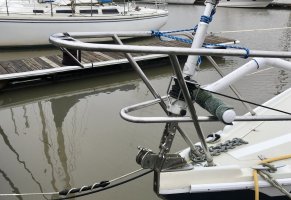The "R" word
Thanks Loren! We had a blast on the DDR this year. I have done it for a few years prior to this year, but never with a spinnaker. I've got a great crew of young, strong guys that have good balance, middle aged guys (me for example) that would probably fall off the foredeck if we were heeling ;-) and older guys that have been sailing since they were kids and bring a lot of practical experience to the crew. Most of us have been sailing and racing together for the past five years so we know how each of us is on a boat with makes adding something new like a spinnaker a fairly easy thing.
I don't understand how sail numbering works, I had always thought that you could choose whatever designation you want. Some of the boats I race against have just letters and some don't have anything at all.
Seascape was sold new in 1985, so that would mean that in the years between out two boats, there could have been as many as 74 E32-3's sold, if that's the way numbering works.
Do you race your boat?
Mike
IIRC, blocks of sequential numbers are available for each sailing geographic area of the country. For instance the first two numbers are different for boats first registered with UYRU (as it used to be called) up here in the NW.
The idea is that when traveling around to enter races, each competitor would have a discrete number on their sails.
For local racing in my area, an entrant just needs something for the RC to look at that is distinctive to each boat.... so an Ericson that races locally might be ID'd as "E-32 # 324". I used to do a lot of RC time and boats with missing logo's and some (!) sort of sail numbers were the bane of our existence. Occasionally it took the threat of not scoring a boat to get the owner to apply numbers.
After all, Every (!) sailboat potentially has a discrete sail number and class emblem showing
unless the owner or sailmaker was too cheap-__s to put it on the main, and also their number on the overlapping headsails.
Grrrrr........

So, your assigned national number has nothing to do with how many other Ericson's were registered.
Racing. Well, other than the occasional cruising distance "race" we have never done any buoy racing with this boat. I did a ton of racing with the Ranger 20 (all one design) and a couple full-tilt seasons with our former Niagara 26.
Close-order racing "in traffic" is pretty risky with 11000# of Olson 34, against some skippers with no regard for gel coat, and performed in a constricted venue like our river. That is just my opinion, and worth less than a penny.

Cheers,
Loren


